|
1.
CENTRAL/ WEST AFRICA
Greater price volatility amid sagging US and UK economies
Log prices have re-adjusted to their recent median levels.
With the current strains on the US and European
economies and the IMF¡¯s low growth forecasts for UK and
US, it is likely that prices for logs and lumber will become
more volatile through 2008. Price movements, both
upwards and downwards may tend to be larger for
European buyers who are more nervous about making
long-term purchase contracts and revert to a ¡®just in time¡¯
policy.
So far, demand for West African timbers has been at
normal level though prices for a very few species have
fluctuated in the past few weeks. Buyers in Europe
contend that the market has now changed to be led by
demand rather than supply, pointing to the oversupply
situation in the softwood sector. Meanwhile, demand from
China and India remains firm.
At this stage it is not clear how far the imminent recession
in the US will impact tropical hardwood imports. If the
crisis in the housing sector deepens, the major effect is
expected to be on imports from major suppliers in South
America, which may trigger pressure for suppliers in the
region to move more aggressively into the European
market. China is a major supplier of furniture and other
wood products into the US and any reduction in demand
for China¡¯s products could also cause lower demand for
African and other timbers.
While the outlook for the African timber market is much
more unpredictable, its current status is relatively stable.
West African exporters are possibly less optimistic about
market prospects than they were at the start of the year and
the high euro is yet another factor affecting this sentiment.
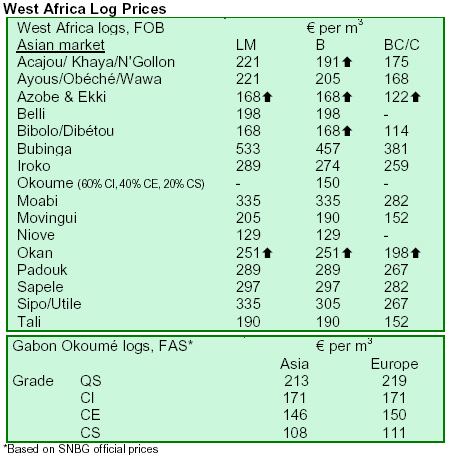
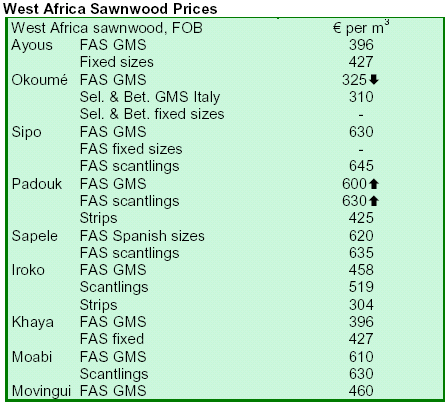
2. GHANA
Forestry Commission cracks down on illegal logging
The Forestry Commission (FC), in conjunction with the
Regional and District Forestry Officers of the Forest
Services Division (FSD), stepped up efforts to combat
illegal and indiscriminate felling of trees to protect
Ghana¡¯s environment. The FC has worked with military
and police teams to shut down illegal operators in the
country. The FSD had also engaged a number of
communities and private forest plantation developers over
the past years to replant degraded areas of forest reserves
as part of the Taungya System. Exotic species, notably
cedrela and teak, and indigenous species like wawa, emire,
mahogany, edinam, chenchen, ceiba and papao had being
planted under the initiative.
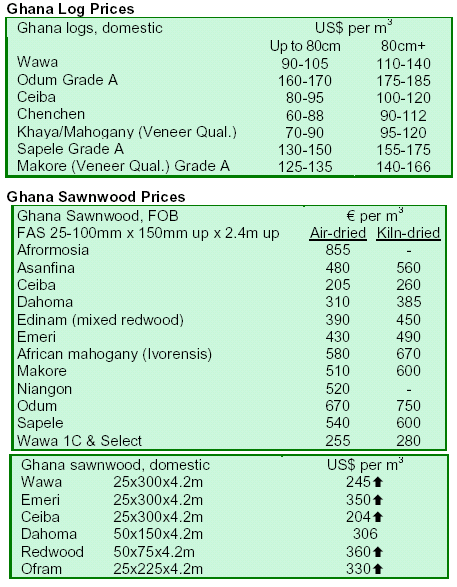
3.
MALAYSIA
Prices surge across the board for Malaysian timber products
Prices of Malaysian timber product continue to rise amid
soft commodity prices. Rubber latex, the raw material for
rubber gloves, has undergone price hikes once every two
to three weeks. This has driven up the cost of rubberwood
on almost a weekly basis for furniture manufacturers.
Malaysia is the world¡¯s leading exporter of natural rubber
gloves, particularly for medical purposes. The demand for
raw latex is not expected to ease for the rest of the year,
and this could create a critical shortage of rubberwood for
Malaysian furniture manufacturers.
In addition, prices of palm oil continue to rise on
speculation that soya bean farmers in Argentina may
refuse to participate in the new planting season, increasing
the stakes for Malaysia in the biodiesel market. Fibers
from the oil palm trees are one of the main sources of raw
material for panel products, including MDF and plywood.
Prices of Malaysian timber products are further driven up
by reports of strikes by port workers in Indonesia. The fear
of worsening haze conditions due to increased fire risk
from La Niña towards the third quarter of this year is
another major contributory factor to the appreciating
prices. The climatic conditions could also cause a serious
drop in the yield of rubber latex and palm oil.

4.
INDONESIA
Port strikes stall movement in Indonesian prices
Prices of Indonesian timber products remained unchanged
amid reports of a major strike by port workers following
legislation passed by the Indonesian government to end
state controls on the operation and administration of ports
across Indonesia. Buyers had voiced concerns over the
possibility that contracted shipments would not be
delivered from Indonesia. Plywood manufacturers were
equally worried over the situation posed by major labor
strikes at the ports. The implication for Indonesian timber
products manufacturers was that they could miss out on
summer construction in most importing countries.
Heart of Borneo agrees to protect forest areas
Antara News reported that the second meeting of the Heart
of Borneo initiative, comprising Indonesia, Malaysia and
Brunei Darussalam, convened from 1-4 April 2008 and
agreed on measures to protect forests. Mr. Nur Hidayat, a
senior Indonesian agriculture ministry official, explained
that the objectives agreed at the meeting were, inter alia,
¡®utilization of protected and conservation forests in
accordance with their classifications; processing of forest
products based on conservation principles;...making
efforts to save and maintain forests in line with their
functions; [and] increasing local communities¡¯
participation in conserving forests.¡¯ Nur noted that the area
designated as the ¡®Heart of Borneo¡¯ consisted of a total of
200,000 km2, 57% of which was located in West
Kalimantan.

5.
MYANMAR
Yearly trends show limited changes in log prices
The period from April 2007¡ªApril 2008 showed a limited
range of price changes for Myanmar logs despite some
impacts on supply. Following EU restrictions on the
purchase of timber from Myanmar, exports to Europe had
not been significant both quantitatively and qualitatively.
Unlike the period before 1990, shipments to Europe were
dwindling. The availability of highly sought after grades
(sawing grade 2 and above) preferred by European buyers
had been scarce. As teak shipments to Europe and Hong
Kong dropped and as the grades declined, India entered
the Myanmar market as a strong buyer in the 1990s,
followed by China and Vietnam. The latter two countries
had also become noteworthy customers for other non-teak
hardwoods.
New hardwood prices on 27 February 2008 showed an
increase of 5% for pyinkadoe and 10% for gurjan logs.
Sales of pyinkadoe remained bearish during the second
half of 2006 and almost throughout 2007. It was only in
the final months of 2007 that pyinkadoe strengthened in
the market. Pyinkadoe was a durable species and had
shown more resilience than gurjan.
New gurjan list prices rose by 10% from prices a year ago.
While the price rises have benefited the MTE, the middlemen
that trade between the MTE and end users have seen
their gains eroded. There were also reports that a ¡®price
war¡¯ erupted among some importers and users.
Species like padauk and tamalan have not been included in
the price list. These species have only been sold by
competitive bidding because of the scarcity of the species
and the high prices they obtain in the tenders. April is not
expected to be a busy month for trading due to the
Myanmar New Year from 11-20 April 2008.
The February TTM report (TTM 13:3) mentioned that
260,000 m3 of Myanmar¡¯s sawnwood was imported by
China in 2007. Some analysts believe this number is not
reliable and will result in trade data discrepancies between
Myanmar and China. At present, land route shipments
require approval from the Trade Council of Myanmar and
border trade approval is granted on a case-by-case basis.
The maximum quantity permitted for shipment is less than
50,000 hoppus tons (about 90,000 m3).
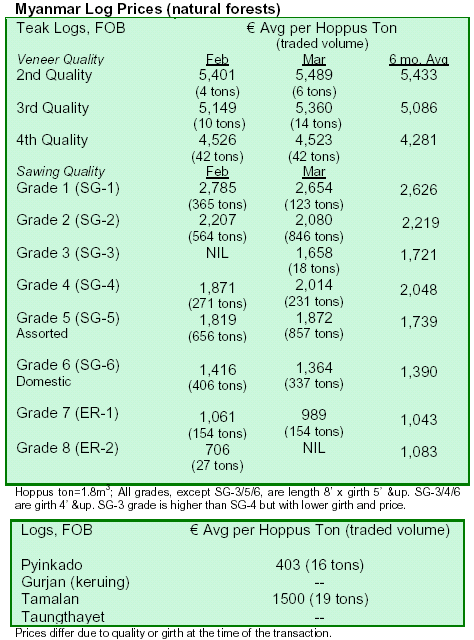
6.
BRAZIL
Legality concerns squeeze Par¨¢ state timber supply
Over 80% of the Northern Amazonian state of Par¨¢ is
covered by forests. The year 2007 was difficult for the
state¡¯s timber sector, said Folha da Mata, as increasing
scrutiny was placed on timber supply to ensure it was
extracted from legal sources. The prevalence of illegal
timber in Par¨¢ made timber companies¡¯ activities
unsustainable and was a deterrent to investment in timber
production, placing the timber industry, the second most
important social and economic activity in the state) at risk.
It was close to collapse due to the delay in the approval of
forest management plans, trade barriers on land tenure and
changes in legal requirements. As a result, many
municipalities with forest-based production faced
unemployment and escalating violence.
According to the Altamira Timber Industry Union, access
to information on registered forest management plans at
the State Environment Agency (SEMA) has improved
with the creation of the Forest Crises Follow-up Group.
However, the number of approved projects was still not
sufficient to generate supply for the many forest
operations. Land issues were considered the main problem
in the region. Only five out of 25 timber companies in
Altamira were operating at about 60% capacity, while the
others have closed.
Despite the difficulties faced by the state in 2007, timber
companies have used natural resources more efficiently,
adding value to products, in line with the new
development model promoted by the state government.
Consequently, the state of Par¨¢¡¯s total export value in US
dollars rose 23% in 2007, almost 10 times the growth in
volume, which increased only 2% in 2007 compared to
2006. This result reflects the impact of value-added
activities and price adjustments to manufactured products
to compensate the depreciating US dollar against the Real.
Prospects for 2008 remain favorable considering the
effective oversight of forest concessions by state and
federal governments. Experts suggest that prospects would
improve if there is greater efficiency in local government
agencies. In addition to changes in the forest
administration, companies will rely on forest plantations,
forest concessions and establishment of forest partnerships
with communities to guarantee timber supply. In 2008, the
Timber Industry Association of Par¨¢ (AIMEX) will be
working to establish an adequate forest policy for the
region that will ensure greater stability and increase timber
activities in the state.
IBAMA tightens control on illegal logging in the Amazon
According to Remade, The Brazilian Institute of
Environment and Renewable Resources (IBAMA) has
been strengthening its control system to combat
deforestation in the Amazon. IBAMA¡¯s website has now
made public a list of all embargoed areas where illegal
activities have taken place. The list will be updated daily
for inclusion and exclusion of areas. The inclusion of an
area on the list will occur when inspectors identify illegal
logging, prosecute a violator and embargo the area. Such
actions are part of the National Preventative Plan to
Combat Deforestation in the Amazon (PPCDAM). For
each area, the information will contain the term of the
contract, date, size of the embargoed area, violation
number, detail of the property, name of the violator and
the name of the operation. The website allows a search to
be conducted by state and municipality and presents all the
information on embargoed areas in the selected location.
Public consultation is in an experimental phase during the
first half of April 2008. Therefore, access to the database
does not require registration. After the initial testing phase,
a user may register on the IBAMA website to receive a
password for conducting searches.
Brazil exports jump 14% in February
In February 2008, the value of exports of general wood
products (except pulp and paper) increased 14% compared
to the same period in 2007, growing from USD289 million
to USD329.5 million. The charts below show the volume
and value of exports over the February 2007¡ªFebruary
2008 period:

IBAMA halts movement of illegal timber
IBAMA prevented 1,500 m3 of high value illegal timber
from passing through the port of Santar¨¦m in the Northern
Amazonian state of Par¨¢, reported Agroflorestal. Part of
the illegal shipments included species such as
macaranduba, jatob¨¢ and ipe; the remaining 3,500 m3 of
sawntimber was released for export. Exporters suspected
of transporting illegal timber could be fined up to
BRL300,000. The operation to stop illegal trade, called
¡®Made in Brazil¡¯, started on 26 March 2008 by the
Executive Manager of IBAMA (GEREX) in Santar¨¦m.
The inspection was conducted by IBAMA as part of the
national campaign ¡®Amazon Guardian¡¯ designed to
combat deforestation, selective logging, transport and
illegal timber trade within the National Preventative Plan
to Combat Deforestation (PPCDAM).
Southern Brazil benefits from European technical fair
MB Comunicação reported on Santa Catarina¡¯s recent
successful negotiations with European importers in March
2008. The visit of the European importers was a result of
the participation of Brazilian furniture companies at the
Valencia Technical Fair in Spain in September 2007.
During the March 2008 visit, orders were successfully
negotiated with companies from seven municipalities of
Western Santa Catarina. The total volume purchased by
importers was EUR 1 million (about BRL3 million) and
furniture will be exported to Ireland by the end of 2008.
According to the furniture cluster¡¯s general manager, the
business negotiations in Euros facilitated the companies¡¯
in negotiating lower prices, considering the depreciation of
the US dollar against the Brazilian Real.
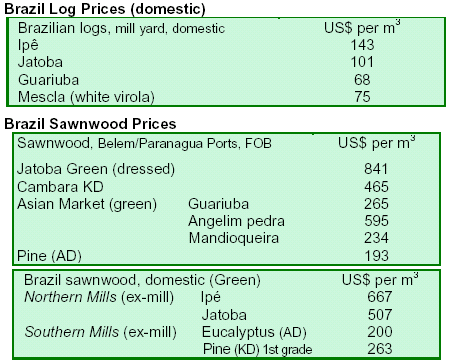
7. PERU
INRENA announces plans to revise yield rates
Jose Luis Camino Ivanissevich, Head of IRENA, recently
stated that investigations into lumber smuggling
operations were not completed with adequate quality and
seriousness required for the job. He said that yield rates for
mahogany and Spanish cedar were based on studies
conducted for other species, making the yield rates (set at
52%) inapplicable to mahogany and Spanish cedar.
Camino announced that in 180 days, a commission would
define a new yield percentage for mahogany, Spanish
cedar and other species. He also pointed out that forest
auditing functions would be given to third parties to enable
the Supervisory Agency for Forest Resources (OSINFOR)
to adequately oversee forest activities. He noted that such
changes to the law were required to fulfill requirements
under the US-Peru Free Trade Agreement.
Peru aims to increase certified forest products exports
According to the Peruvian Commission for the Promotion
of Exports and Tourism¡¯s (PROMPERU) manager for the
forest products sector, Ricardo Dueñas, a 26% increase in
the total value of forest products exports (USD37 million)
resulted in the first two months of 2008 when compared to
the same period in 2007.
On the other hand, Ricardo Dueñas said that PROMPERU
would promote fourteen or fifteen forest concessions with
lumber export certification in Loreto, Ucayali and Madre
de Dios regions. The size of these concessions would
surpass 300,000 hectares. Owners are currently working
with financial institutions and some non-governmental
organizations to secure investment for the initiative.
Investment requirements for these concessions would be
USD13 million and the potential value of concessions,
after wood production and export costs, are estimated to
be about 300 million over a period of five years.

8. BOLIVIA

9. GUYANA
Furniture exports leap 30% in March
Guyana¡¯s furniture exports in March increased almost
30% in value over February 2008 levels. The major reason
for the rise is that outdoor/garden furniture exports
substantially increased to the UK over the February-March
period. Outdoor and garden furniture exports to the UK
market are expected to further rise as spring progresses
and the warmer summer months approach.
Log and sawnwood prices remain stable
Log and sawnwood prices continue to be stable for
Guyana¡¯s main export species. However, due to late starts
in production by some producers, log export volumes have
declined by about 20% from February levels. Resumed
production by main producers and exporters is expected to
bring about some increases in log exports in subsequent
periods. Nevertheless, a balanced export product mix
between primary and secondary processed wood products
is likely to be maintained.
The recent trend for expansion in sawnwood exports
continues as producers seek higher prices in new markets.
Prices for both dressed and undressed sawnwood remains
high in the Asia/Pacific market, with New Zealand and
Australia being the primary destinations in the market.
Barbados is still the largest market for Guyana¡¯s
sawnwood exports.

|